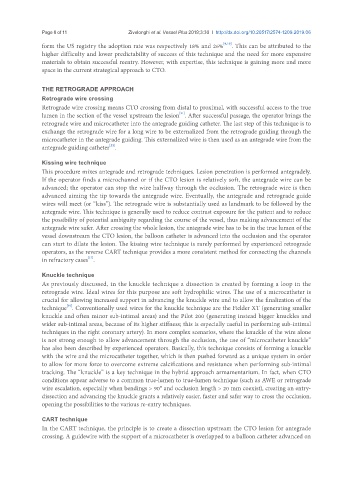Page 284 - Read Online
P. 284
Page 8 of 11 Zivelonghi et al. Vessel Plus 2019;3:30 I http://dx.doi.org/10.20517/2574-1209.2019.06
form the US registry the adoption rate was respectively 18% and 26% [9,10] . This can be attributed to the
higher difficulty and lower predictability of success of this technique and the need for more expensive
materials to obtain successful reentry. However, with expertise, this technique is gaining more and more
space in the current strategical approach to CTO.
THE RETROGRADE APPROACH
Retrograde wire crossing
Retrograde wire crossing means CTO crossing from distal to proximal, with successful access to the true
[21]
lumen in the section of the vessel upstream the lesion . After successful passage, the operator brings the
retrograde wire and microcatheter into the antegrade guiding catheter. The last step of this technique is to
exchange the retrograde wire for a long wire to be externalized from the retrograde guiding through the
microcatheter in the antegrade guiding. This externalized wire is then used as an antegrade wire from the
[22]
antegrade guiding catheter .
Kissing wire technique
This procedure mixes antegrade and retrograde techniques. Lesion penetration is performed antegradely.
If the operator finds a microchannel or if the CTO lesion is relatively soft, the antegrade wire can be
advanced; the operator can stop the wire halfway through the occlusion. The retrograde wire is then
advanced aiming the tip towards the antegrade wire. Eventually, the antegrade and retrograde guide
wires will meet (or “kiss”). The retrograde wire is substantially used as landmark to be followed by the
antegrade wire. This technique is generally used to reduce contrast exposure for the patient and to reduce
the possibility of potential ambiguity regarding the course of the vessel, thus making advancement of the
antegrade wire safer. After crossing the whole lesion, the antegrade wire has to be in the true lumen of the
vessel downstream the CTO lesion, the balloon catheter is advanced into the occlusion and the operator
can start to dilate the lesion. The kissing wire technique is rarely performed by experienced retrograde
operators, as the reverse CART technique provides a more consistent method for connecting the channels
[17]
in refractory cases .
Knuckle technique
As previously discussed, in the knuckle technique a dissection is created by forming a loop in the
retrograde wire. Ideal wires for this purpose are soft hydrophilic wires. The use of a microcatheter is
crucial for allowing increased support in advancing the knuckle wire and to allow the finalization of the
[19]
technique . Conventionally used wires for the knuckle technique are the Fielder XT (generating smaller
knuckle and often minor sub-intimal areas) and the Pilot 200 (generating instead bigger knuckles and
wider sub-intimal areas, because of its higher stiffness; this is especially useful in performing sub-intimal
techniques in the right coronary artery). In more complex scenarios, where the knuckle of the wire alone
is not strong enough to allow advancement through the occlusion, the use of “microcatheter knuckle”
has also been described by experienced operators. Basically, this technique consists of forming a knuckle
with the wire and the microcatheter together, which is then pushed forward as a unique system in order
to allow for more force to overcome extreme calcifications and resistance when performing sub-intimal
tracking. The “knuckle” is a key technique in the hybrid approach armamentarium. In fact, when CTO
conditions appear adverse to a common true-lumen to true-lumen technique (such as AWE or retrograde
wire escalation, especially when bendings > 90° and occlusion length > 20 mm coexist), creating an entry-
dissection and advancing the knuckle grants a relatively easier, faster and safer way to cross the occlusion,
opening the possibilities to the various re-entry techniques.
CART technique
In the CART technique, the principle is to create a dissection upstream the CTO lesion for antegrade
crossing. A guidewire with the support of a microcatheter is overlapped to a balloon catheter advanced on

